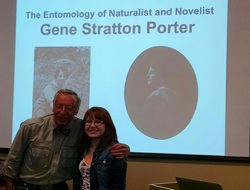 Tom Turpin and his assistant Alex Forsythe
Tom Turpin and his assistant Alex Forsythe Gene Stratton-Porter, one of Indiana's best-known authors, was known as the "Bird Woman" in real life. She could just as well have been known as the "Moth Woman." Born in 1863 in the small town of Lagro in Wabash County, she was the youngest of 12 children. With all those kids in the family, the youngest didn't get a lot of attention, so Stratton-Porter learned to play by herself as she grew up. The outdoors became her playground, and that is where she developed her lifelong love of nature, including birds and moths.
Following her marriage and birth of her only child, Stratton-Porter continued her interest in nature but found very few books written about natural history. So she was forced to answer questions through her own research. To facilitate this activity, Stratton-Porter became a skilled photographer. Then when she started to write about her work, publishers were unsure about how marketable works of natural history were, so she began to write novels.
And the rest of the story, as they say, is history. Stratton-Porter's novels made her one of the best-selling authors of her time and that success allowed her to publish non-fiction works as well. In all of her works her unbridled love of nature takes center stage.
Many characters in Stratton-Porter's novels are based on real people, including Stratton-Porter herself. For example, in "Freckles," one of her best-known novels, one character is the bird woman who photographs birds and collects insects. Her first novel was "Song of the Cardinal" about a red bird that met a man named Abram, who was clearly based on Stratton-Porter's father.
Stratton-Porter wrote a scientific publication called "Moths of the Limberlost." In this book she points out that there is a difference between a naturalist and a nature lover. The naturalist "devotes his life to delving into stiff scientific problems…" while a nature lover "finds recreation in being out of doors and appreciating the common things of life as they appeal to his senses."
She concludes that scientific naturalists get lost in the details, such as the number of veins in a wing, and miss the big picture. For example, the issue about how moths that emerge from pupae buried in the soil get out of the ground. It is not the moth that crawls from the ground, as some of the literature of her day asserted. According to Stratton-Porter, moths were too fragile to crawl through the soil without showing obvious signs of the wear and tear of such activity. So, by observation, she discovered that the pupae worked its way from the soil using the pointed end of its abdomen. Once above the soil the moth emerged in much the same fashion as cicadas emerging from their immature shells.
Stratton-Porter describes the life cycles of some of the larger and showier moths of Indiana in "Moths of the Limberlost." Her descriptions included tales associated with capturing moths, collecting eggs and rearing caterpillars of moths known today as cecropia, emperor, tomato hornworm, io, underwings, polyphemus, regal, promethea and luna.
One of the most interesting tales is about a moth that Stratton-Porter's father called the Lady Bird. Mentioning that name today brings up thoughts of an insect--a ladybird beetle. But Stratton-Porter's parents thought this moth was a bird similar to the hummingbirds that were hovering before the flowers in search of nectar. But Stratton-Porter was not convinced that the creature was a bird. Her primary reason for this conclusion was that, try as she might, she could not follow the creature to its nest. Then she noticed that the Lady Bird had four wings--not very bird like. Finally, she was able to capture one of the creatures and prove to both of her parents that it was a moth and not a bird. That day-flying moth is one we know today as a white-lined sphinx moth.
Moths play a prominent role in Stratton-Porter's "Girl of the Limberlost." In that novel, a young woman named Elnora Comstock collects moths to sell as a way to pay for her schooling. An activity, by the way, that Stratton-Porter found was useful for putting extra cash in her pocket. Stratton-Porter and her character Elnora Comstock both collected moths by sugaring. This process involves putting a sweet mixture on a tree limb to attract moths feeding during the night hours. So, because birds are day active and most moths are night active, it might make sense to say that Stratton-Porter was the "Bird Woman" by day and the "Moth Woman" by night!
Writer: Tom Turpin
[email protected]
Editor: Olivia Maddox
[email protected]
 RSS Feed
RSS Feed
